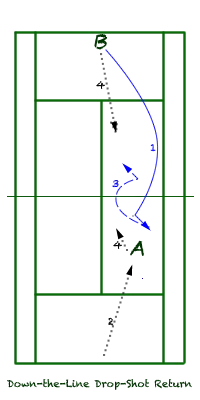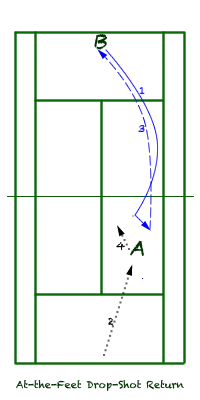When you receive a drop-shot from your opponent, as you move up to get it there are three aspects that should concern you:
1. Getting to the ball before it bounces twice
2. Tactical decision in regard to placement of your return
3. Court positioning to protect against your opponent’s eventual next shot
Getting to the ball in time
When receiving a drop-shot, your reaction to it has a lot to do with the attention you pay to your opponent’s body language.
There are certain cues that give away your opponent’s intention of hitting a drop-shot:
– grip change (most of the time a continental grip is used to deliver drop shots)
– short backswing (necessary to absorb the ball)
– position on the court (your opponent will not attempt a drop shot from the baseline; most of the time it will be sent from well inside the baseline).
A skilled player delivers a drop-shot while disguising it very well: pretending that he’ll hit a drive shot (bigger backswing) and just before swinging he would change the grip (or not) and soften the impact.
In this latter situation, it is up to you to react quickly as soon as you notice the change in swing pace and path (high to low).
Moving to the ball quickly and in a timely manner will depend on your court position, footwork, speed, and quick reaction.
Now let’s assume that you were quick enough to spot the drop-shot (short ball) coming and you are now moving to reach it.
As you approach the ball, you must quickly asses your return options:
a). Angled drop-shot
b). Down-the-line drop-shot
c). Deep at opponent’s feet
d). Heavy slice (under-spin)
a). See the “Angled Drop-Shot Return” graphic below

If your opponent stays back or close to the baseline, hit an angled drop-shot, away from your opponent.
The only concern that you might have to face is your opponent being quick and getting to the ball – this angled drop-shot opens up the court for a put-away; so you must be sure to get behind the ball quickly and in balance, or your angled drop shot is difficult to reach by your opponent.
b). See the “Down-the-Line Drop-Shot Return” graphic below

Send a drop shot back down-the-line – by keeping the ball in front of you, if your opponent reaches it you have a better chance to cover the court and block his return with a volley; you do not have to scramble to cover the court and you’ll be in better balance to close the angles compared to the previous option (angled drop-shot).
c). See the “At-the-Feet Drop-Shot Return” graphic below

Hit it deep at your opponent’s feet – do this only if you get to the ball early and catch it high enough to hit it comfortably over the net; position yourself just behind the path of the ball and not too close to the net (prepare for a passing shot lob).
d). Slice it with lots of spin effect – this will keep the ball low and make it hard for your opponent to get under it for a lob. Besides, counteracting the under-spin and sending the ball high is another difficult task for your opponent to execute.
This makes returning a drop-shot with a heavy slice one of the best options assuming you get to the ball by the time it does not get too low under the net.
Final tips:
If you are a beginning player, use the first option (angled drop-shot); for a more advanced player you can use any one of the four options depending on where your opponent is positioned after delivering the drop shot; by the way, if your opponent is an experienced player he should come closer to the service line after hitting the drop-shot.